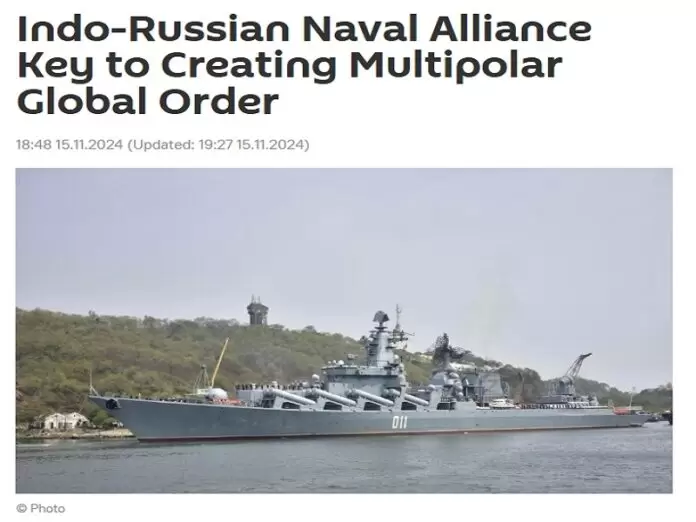Here’s the full interview that I gave to Sputnik India last week, excerpts of which were published in their report titled “Indo-Russian Naval Alliance Key to Creating Multipolar Global Order”.
1. How would an increased Russian participation change the strategic dynamics in the Indian Ocean Region (IOR) vis-a-vis the US?
An increased presence could come about if the two countries finally signed the long-awaited Reciprocal Exchange of Logistics (RELOS) agreement that could allow each to use the other’s facilities for logistical purposes.
A greater and more regular Russian role in the IOR would balance out the Sino-US competition there by having Russia serve as a reliable third-party partner for countries to cooperate with instead of the seemingly zero-sum Sino-US choice.
Despite the NATO-Russian proxy war in Ukraine, Russia and the US are not in a hot war, and their competition in other countries is political and economic, not military. Also, even though China is a close Russian partner, it’s not a military ally.
Accordingly, partnering with it instead of the US or China shouldn’t be seen by either of those two as an unfriendly action. In fact, they might prefer for others to partner with Russia instead of with their respective superpower rival.
Therefore, far from worsening New Cold War tensions, an increased Russian presence in the IOR could eventually help alleviate them as the New Cold War’s main front is expected to shift from Europe to Asia under Trump 2.0.
2. Russia and India have been the two biggest champions of multipolarity. How does their cooperation in the IOR contribute to fostering a more balanced, multipolar approach to regional security?
The seemingly inevitable shift of the New Cold War’s main front from Europe to Asia under Trump 2.0 upon the end of the NATO-Russian proxy war in Ukraine, whenever that may be and regardless of whatever speculative terms will be agreed to, will relieve pressure on both Russia and India.
The Western pressure on Russia right now is obvious and multidimensional while the same on India is mostly focused on economic pressure through secondary sanctions threats as well as the political domain by unsuccessfully trying to impugn its international reputation for remaining neutral in the abovementioned conflict.
Closer Russo-Indo cooperation in the IOR, especially its naval dimension if RELOS is finally signed, can supercharge their shared vision of serving as a joint third pole of influence in an increasingly bifurcated Sino-US world whose systemic effects would be much more strongly felt as the New Cold War shifts to Asia.
They can therefore form a reliable third party with which other countries can partner who’d prefer to be neutral in the Sino-US front of the New Cold War that’s expected to intensify under Trump 2.0 instead of feel pressured to side with either of those superpowers at the risk of offending the other.
This could accelerate latent tri-multipolarity processes in the sense of helping to overcome bipolar Sino-US pressures on the global system, especially if the end of the NATO-Russian proxy war in Ukraine is followed by phased Western sanctions relief for Russia that reduces its perceived dependence on China.
3. What kind of a role do you envision for Russia in the IOR where the Indian Navy is the dominant force? How could India benefit from increased Russian participation in the IOR?
India is perceived by some in the IOR as being on the America’s side in the re-emerging Sino-US front of the New Cold War in Asia, even in spite of last month’s border deal in the Himalayas, but partnering with Chinese-friendly Russia can reshape those perceptions.
Likewise, Russia is perceived by some as being on China’s side in this same competition, even though China informally complies with some Western sanctions on Russia, which is why partnering with US-friendly India would reshape those perceptions too,
Russia and India would accordingly be seen as more neutral in that re-emerging front than as pro-Chinese/anti-American and pro-American/anti-Chinese respectively like they now are, thus raising the chances of being seen collectively as a reliable third-party balancing force.
The grand strategic goal is for the Russo-Indo Strategic Partnership to accelerate latent tri-multipolarity processes by functioning as the basis for an Afro-Eurasian New Non-Aligned Movement (“Neo-NAM”) that would maintain systemic stability amidst worsening Sino-US tensions.
This informal network, likely comprised of many minilaterals centered on Russia, India, and Russia-India together, can then defend against increasingly stronger bipolarity pressures on the global system to advance a more complex form of multipolarity with time.
Excerpts from this interview were published in Sputnik India’s report about titled “Indo-Russian Naval Alliance Key to Creating Multipolar Global Order”.







